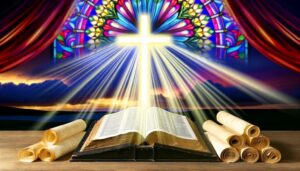Zerubbabel Meaning In The Bible: Rebuilder of the Temple
Zerubbabel, a pivotal figure in the Jewish return from Babylonian exile, is interpreted to mean ‘seed of Babylon’ or ‘born in Babylon,’ reflecting his origins in captivity. His name and leadership symbolize hope and restoration, capturing the divine promise of renewal despite displacement.
As governor of Judah, he played a central role in laying the foundations of the Second Temple, supported by prophets Haggai and Zechariah. Zerubbabel‘s lineage from the house of David bolstered messianic expectations and underscored his crucial role in Jewish restoration.
His story illuminates strong themes of perseverance, faith, and unity amidst adversity, providing deeper insights into his legacy.
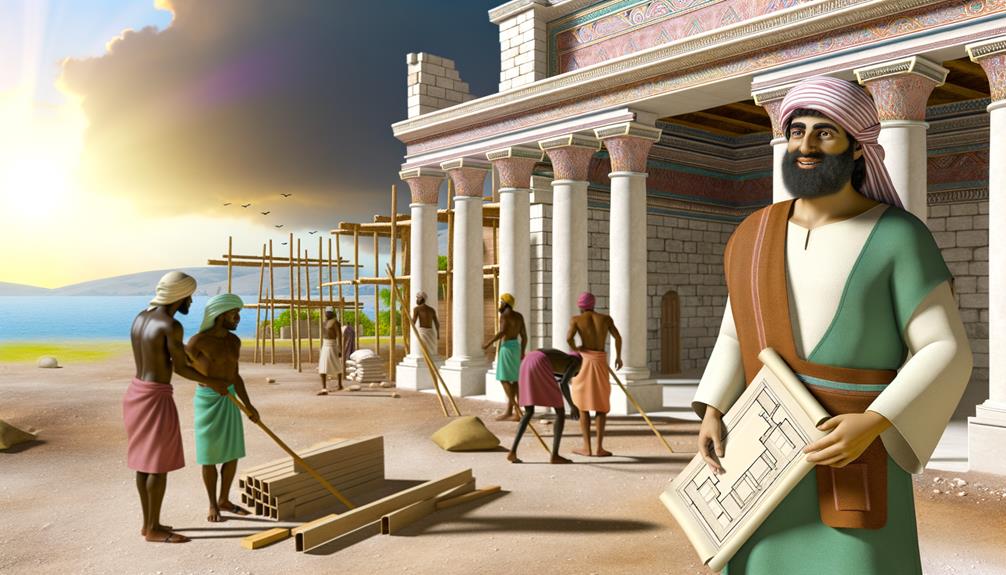
Zerubbabel Meaning in the Bible: Significance and Symbolic Role
| Aspect | Details |
|---|---|
| Name Meaning | Zerubbabel means “Seed of Babylon” or “Born in Babylon” |
| Biblical Role | Governor of Judah, led the first group of Jews back from Babylon |
| Key Contributions | Oversaw the rebuilding of the Temple in Jerusalem |
| Lineage | Descendant of King David; ancestor of Jesus Christ |
| Scriptural References | Haggai 1–2, Zechariah 4, Ezra 3–5, Matthew 1:12–13 |
| Symbolism | Restoration, leadership, divine purpose, and faith under opposition |
Etymology of Zerubbabel

Derived from the Hebrew name Zəru bbāvel, the etymology of ‘Zerubbabel‘ is often interpreted to mean ‘seed of Babylon‘ or ‘born in Babylon.’ This linguistic analysis points to a deep interconnection between the name and the Babylonian exile.
The Hebrew root ‘zeru’ translates to ‘seed,’ while ‘Babel’ refers to Babylon, the ancient Mesopotamian city. This interpretation underscores the historical and cultural milieu of the Jewish people during the Babylonian captivity.
Understanding the etymology of Zerubbabel provides significant insights into his identity and the broader narrative of Jewish exile and restoration. The name encapsulates not just a personal lineage but a collective memory of displacement and the hope for renewal.
Historical Context
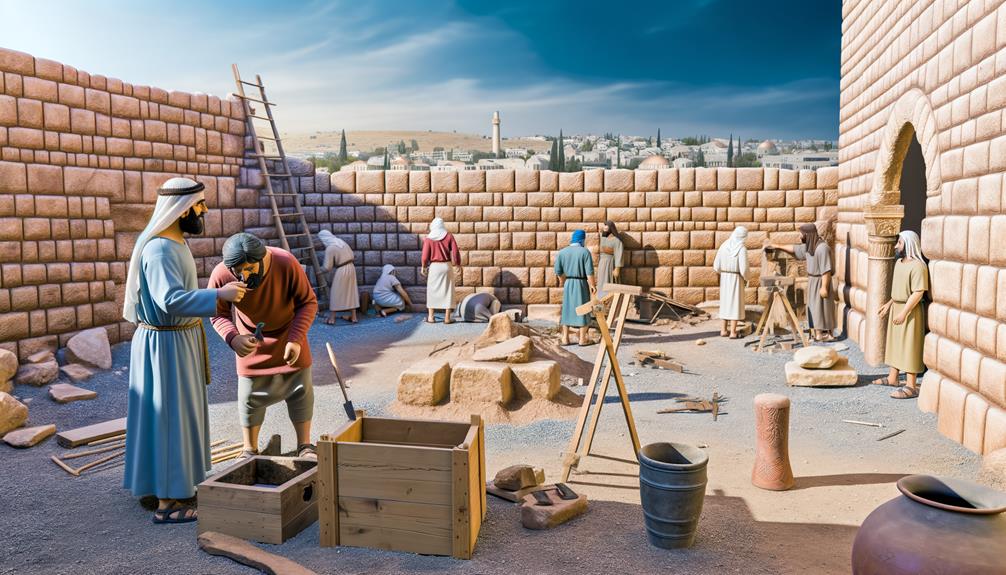
In the historical context of Zerubbabel, his significance is deeply rooted in the period of the Jewish return from Babylonian exile and the subsequent efforts to rebuild the Temple in Jerusalem. Zerubbabel emerged as a pivotal leader during this transformative era, taking on the immense responsibility of guiding the exiles and restoring their place of worship.
His role is critically examined through various historical lenses:
- Leadership: He was appointed as governor, providing essential political and social stability.
- Temple Rebuilding: Instrumental in laying the foundation of the Second Temple.
- Prophetic Support: Received encouragement from prophets Haggai and Zechariah.
- Challenges: Faced opposition from local adversaries and external pressures.
This context underscores Zerubbabel’s indispensable role in Jewish history.
Zerubbabel’s Lineage
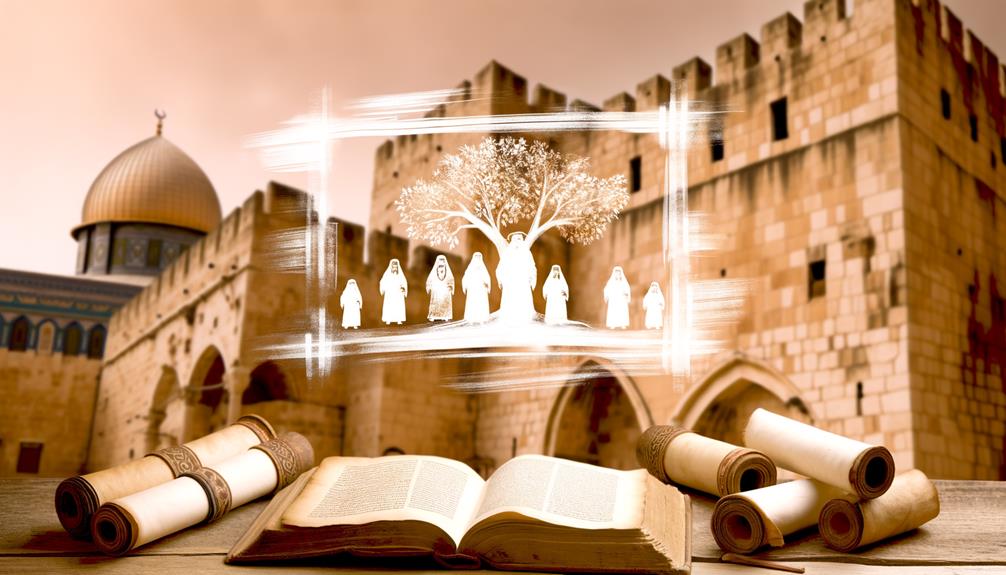
Zerubbabel’s lineage is traced back to the royal house of David, positioning him within a significant genealogical and theological framework in Jewish tradition.
As the grandson of Jehoiachin, the penultimate king of Judah before the Babylonian exile, Zerubbabel’s heritage is rooted in the Davidic dynasty, which holds profound implications for Jewish messianic expectations.
His paternal line through Shealtiel and Jehoiachin underscores his legitimate claim to leadership and continuity of the Davidic promise.
This lineage is meticulously chronicled in biblical records such as 1 Chronicles 3:17-19 and Matthew 1:12, affirming Zerubbabel’s pivotal role in post-exilic Judah.
His Davidic descent not only validated his leadership but also reinforced theological hopes for the restoration of Israel under a divinely sanctioned ruler.
Role in Rebuilding the Temple
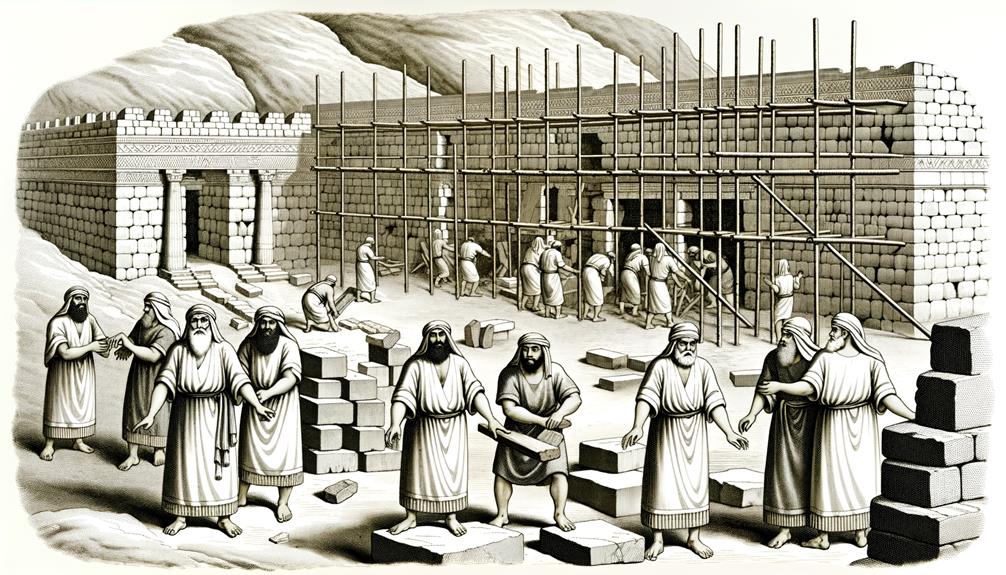
Zerubbabel’s leadership was pivotal during the reconstruction of the Second Temple, as he guided the Jewish people through a period of significant restoration and renewal.
He faced numerous challenges, including opposition from surrounding adversaries and internal discouragement among the Israelites.
Despite these obstacles, Zerubbabel’s steadfast faith and commitment to God’s directives were instrumental in the successful rebuilding of the Temple.
Leadership During Reconstruction
Among the pivotal figures in the post-exilic period, Zerubbabel stands out for his instrumental role in leading the Jewish community during the reconstruction of the Second Temple.
His leadership was characterized by:
- Visionary Guidance: Zerubbabel provided a clear vision for the temple’s reconstruction.
- Spiritual Dedication: He emphasized the importance of spiritual renewal alongside physical rebuilding.
- Political Acumen: Effectively navigated Persian imperial politics to secure support and resources.
- Community Mobilization: Unified the Jewish people, encouraging collective effort and participation.
Zerubbabel’s leadership was marked by a blend of spiritual fervor and practical wisdom, ensuring the successful laying of the temple’s foundations and fostering hope amongst the returning exiles.
Challenges Faced Rebuilding
Despite Zerubbabel’s visionary leadership, the reconstruction of the Second Temple was fraught with numerous obstacles that tested the resilience and determination of the Jewish community.
Political opposition from surrounding regions, particularly from the Samaritans, sought to halt progress through intimidation and bureaucratic interference.
Economic hardship also played a significant role, as the returning exiles struggled to secure resources and labor necessary for the monumental task.
Additionally, internal dissent and apathy among the Jewish populace further complicated efforts, as some questioned the feasibility and priority of the project amidst their own personal struggles.
Nevertheless, through steadfast faith and unyielding commitment, Zerubbabel and his compatriots persevered, ultimately laying the foundation for a renewed center of worship and communal identity.
Zerubbabel and Prophecy
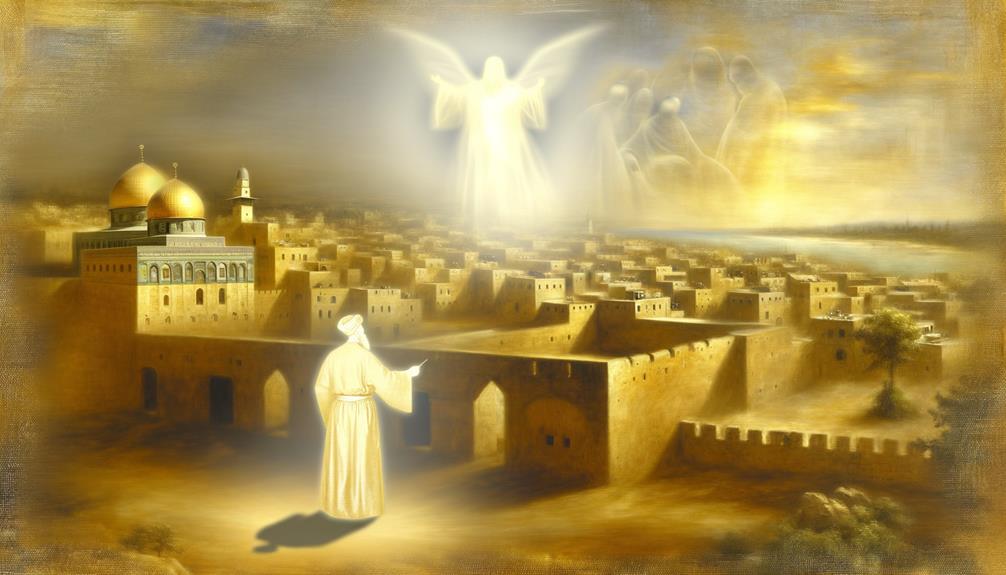
Zerubbabel’s pivotal role in the restoration of the Jewish community post-exile is underscored by prophetic literature, which often aligns him with themes of renewal and hope.
Additionally, his inclusion in the Messianic lineage as outlined in the genealogies of Jesus underscores the theological significance attributed to his leadership.
This intersection of prophecy and lineage invites a deeper examination of his enduring legacy in biblical narrative and eschatology.
Zerubbabel’s Role in Restoration
How does Zerubbabel’s pivotal role in the restoration of Jerusalem reflect the fulfillment of biblical prophecy and divine purpose? As the governor of Judah, Zerubbabel led the first group of Jewish exiles back from Babylon and spearheaded the rebuilding of the Second Temple, signifying a critical juncture in biblical history.
His actions were in direct alignment with prophetic declarations from Haggai and Zechariah, who emphasized his divine appointment.
- Rebuilding the Temple: A key act in fulfilling prophecy (Haggai 1:1-15).
- Lineage of Royalty: Descendant of David, affirming God’s covenant.
- Divine Favor: Recognized by prophets as chosen by God.
- Symbol of Hope: Represented restoration and renewal for the Jewish people.
Zerubbabel’s mission consequently underscored God’s unwavering fidelity to His promises.
Messianic Lineage and Zerubbabel
Understanding Zerubbabel’s place in the messianic lineage underscores the intricate fulfillment of biblical prophecy, tying his role directly to the promises made to the house of David.
Zerubbabel, a descendant of King David, is pivotal in the genealogies presented in Matthew 1:12-13 and Luke 3:27, bridging the Babylonian exile to the coming of Jesus Christ.
His leadership in rebuilding the Temple in Jerusalem not only restored physical worship but also symbolized the restoration of God’s covenant with His people.
Prophecies in Haggai 2:23 and Zechariah 4:6-10 highlight Zerubbabel as a signet ring, affirming God’s sovereign plan.
Consequently, Zerubbabel’s life and mission foreshadow the ultimate redemption through Jesus, reaffirming divine fidelity to Davidic promises.
Symbolism in Zerubbabel’s Name
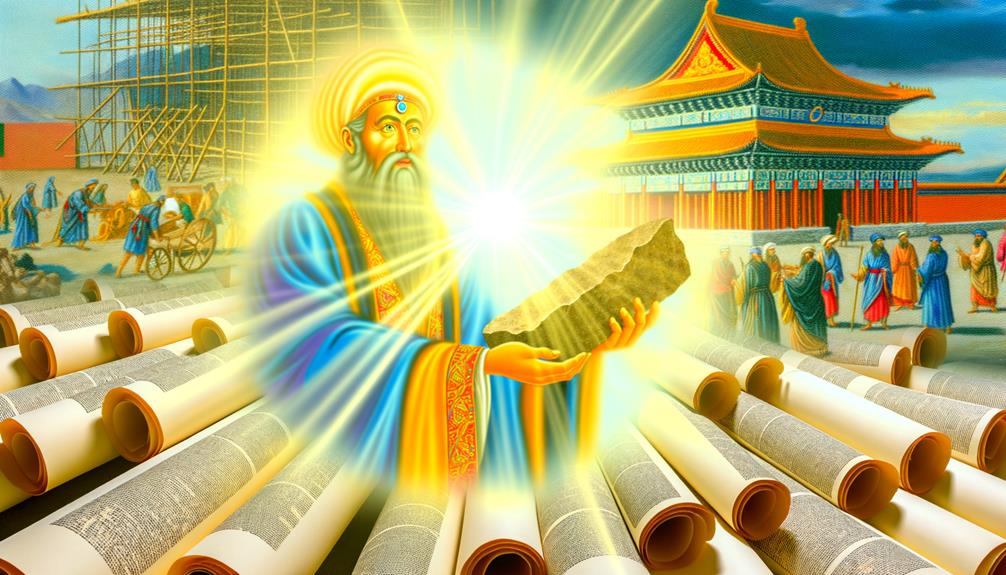
The name Zerubbabel, often interpreted as ‘seed of Babylon’ or ‘born in Babylon,’ carries profound symbolic significance that transcends its literal meaning. This name encapsulates the intersection of exile and hope, pointing to a narrative of restoration and divine providence.
Symbolically, Zerubbabel’s name can evoke the following themes:
- Exile and Displacement: Signifying the Babylonian captivity.
- Divine Purpose: Indicating God’s plan for His people even in foreign lands.
- Restoration: Foretelling the rebuilding of the Temple and Jerusalem.
- Leadership: Representing a figure chosen to guide and inspire.
Thus, Zerubbabel’s name is imbued with layers of meaning, resonating deeply within the biblical narrative.
Zerubbabel in the Old Testament
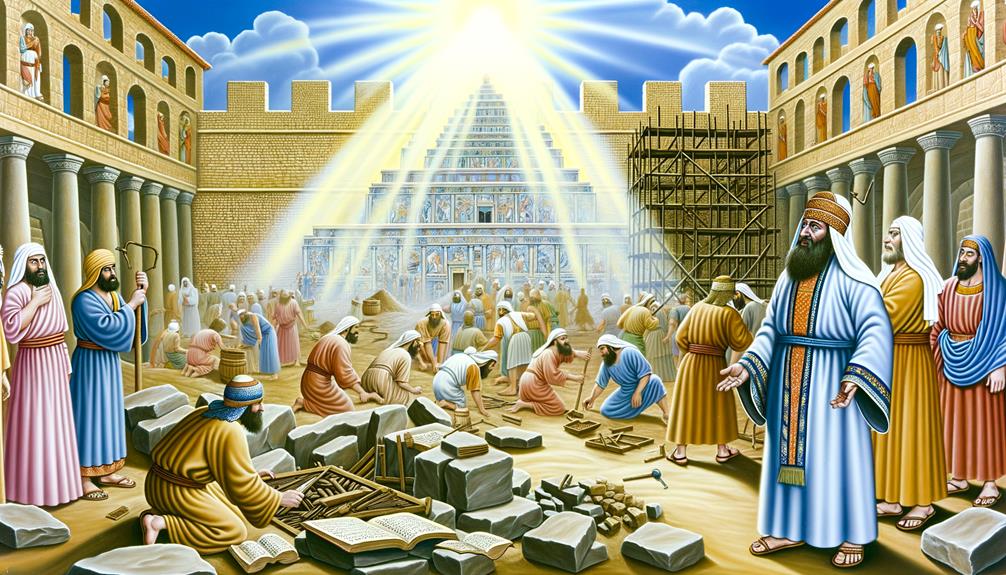
Within the Old Covenant, Zerubbabel emerges as a pivotal figure in the post-exilic period, playing an essential role in the reconstruction of the Temple in Jerusalem.
Appointed as governor of Judah under Persian rule, he is prominently featured in the books of Ezra and Haggai. Zerubbabel’s leadership was instrumental in galvanizing the Jewish community to rebuild the sacred edifice, despite significant opposition and discouragement.
His lineage, tracing back to the Davidic line, symbolically connected the restoration efforts to ancient promises and royal heritage.
Significantly, in Zechariah, Zerubbabel is portrayed as a beacon of hope, his hands laying the foundation and completing the Temple, emphasizing divine endorsement and fulfillment of prophetic visions.
Spiritual Lessons From Zerubbabel

How does Zerubbabel’s unwavering commitment to rebuilding the Temple serve as a profound lesson in perseverance and faith amid adversity? Zerubbabel’s journey illustrates key spiritual principles that resonate deeply with those facing challenges today.
His leadership under divine guidance and his steadfastness despite opposition offer a blueprint for maintaining faith and purpose.
- Perseverance: Zerubbabel’s determination in the face of obstacles teaches the importance of resilience.
- Faith: His reliance on God’s promises underscores the power of faith during trials.
- Leadership: Zerubbabel exemplifies spiritual leadership grounded in trust and obedience to God.
- Community: His efforts fostered unity and collective purpose among the Israelites.
These lessons remain pertinent for modern believers traversing their spiritual journeys.
Zerubbabel’s Legacy Today

Zerubbabel’s influence extends beyond his time, offering enduring lessons in perseverance, faith, and leadership that continue to inspire contemporary believers.
As the governor of Judah who led the effort to rebuild the Temple in Jerusalem, Zerubbabel demonstrated unwavering commitment to God’s vision despite substantial opposition and intimidating challenges.
His legacy exemplifies the profound impact of steadfast faith and diligent leadership in the face of adversity.
Modern readers find in Zerubbabel a model for maneuvering complex spiritual and communal duties with integrity and resilience.
Conclusion
The study of Zerubbabel in biblical texts reveals a multifaceted figure who embodies leadership, faith, and divine promise. His name, translating to ‘seed of Babylon,’ symbolizes a journey from exile to restoration.
Historical records and prophecies emphasize his pivotal role in rebuilding the Temple, a task imbued with spiritual significance.
Zerubbabel’s legacy, deeply rooted in Judaic tradition, continues to offer profound lessons in resilience and divine purpose, challenging the faithful to reflect on themes of redemption and perseverance.






